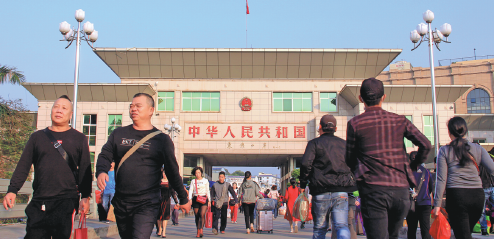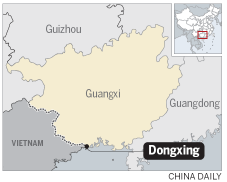Officers bridge commercial and cultural gap
Editor's note: This is the fifth in a series of stories about China's border patrol guards, focusing on the challenges they face and their work to keep the country safe, prevent trafficking of drugs and people, and maintain friendly relations with their counterparts in neighboring countries.

Tourists cross the China-Vietnam border in Dongxing, Guangxi Zhuang autonomous region, last month. ZHAO YIMENG/CHINA DAILY
Every morning, Beilun Bridge in Dongxing, Guangxi Zhuang autonomous region, sees thousands of Vietnamese and Chinese crossing the border, which is marked by a red line that runs across the middle of the structure. When the border post opens at 8 am every morning, people cross, hauling heavy bags on their shoulders or dragging luggage behind them.
Clustered in small groups on the bridge, Vietnamese nationals in conical bamboo hats busily pack and transfer goods to sell in either Dongxing or Mong Cai in northern Vietnam.
Liao Peng, a police officer at the Dongxing Border Control Police Station, kicked off his day by patrolling a commercial strip near the city's port. He visited stores that sell special commodities imported from Vietnam, such as sandalwood products, and spoke with the Vietnamese owners to ensure that the outlets are managed legally and are secure.
In addition to regular patrols around the bustling port area, border officers like Liao undertake more challenging tasks, including apprehending smugglers and illegal immigrants, and overseeing residence and employment permits.
By the start of last month, they had detained 1,300 people involved in such activities this year, according to Liang Shanjun, chief of Dongxing Border Control Police Station.

Land and water
Dongxing is the only port that connects China and Vietnam by both land and water. The border between the two countries runs for more than 1,000 kilometers and lacks obvious natural barriers, which facilitates illegal activities such as smuggling and human trafficking. About 37 km of the border runs through Dongxing.
Before the city government erected defensive barriers along the riverbank in 2013, officers even took chairs and watched the river to spot illegal immigrants swimming across the border and entering China, Liang said.
However, Vietnamese traffickers also arrange for illegal immigrants to bypass checkpoints by taking them along hidden roads in mountainous areas.
The central government has tightened border regulations to prevent human trafficking. In November last year, 17 Vietnamese who worked illegally in Guangdong province arrived in Dongxing in two minibuses, but they were spotted by the border police officers, so they fled back to Vietnam.
After investigating, Liao and his colleagues discovered that a "snakehead"-a human trafficker-surnamed Chen had organized the smuggling operation. Chen, nicknamed Sister Red, is a Vietnamese national who married a Chinese man in Dongxing and takes advantage of her status and permanent residence in the city to organize cross-border human trafficking.
